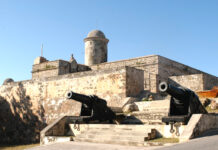
Contents
Particularities of the San Carlos de la Cabaña Fortress
The Fortress of San Carlos de la Cabaña stands as a military complex that is located at the entrance to the Bay of Havana, which next to the fortress of San Salvador de La Punta, the Castillo de la Real Fuerza and the Castillo del Morro defended the island’s capital from enemy or pirate attacks.
Its construction began in 1763 under the direction of the military engineer Silvestre Abarca and received its name in honor of King Carlos III.
Its constructive work concluded in 1774 and it was necessary to build it in that area because the English used that privileged position to defeat the city’s defenses when they invaded Havana.
They restored it together with the city in 1763 in exchange for La Florida. At 9 p.m. a cannon shot is fired daily, which continues the tradition of colonial times to indicate the exact time of the closing of the city walls.
During the independence struggles of the 19th century, many Cuban heroes, including José Martí, were prisoners of their bars and many were also executed in the Pit of Laurels.
The Fortress of San Carlos de la Cabaña and its history
Construction of the San Carlos de la Cabaña Fortress began immediately after Spain managed to recapture Havana from the takeover of the English.
For the construction of this military complex, the most advanced concepts of eighteenth century military engineering were applied, which became the largest on the island and in America.
It had a very large military capacity and its weapons were very efficient. It is estimated that by 1859 it had 120 bronze cannons and howitzers of different calibers.
In 1863, the military equipment reached 245 artillery pieces, in addition to other short-range light weapons.
Since its construction, the Cabaña housed the troops of the Spanish army in Cuba and during the wars of independence it served as a prison and its moat was a site for executions.
In the 20th century, it served as a warehouse, troop accommodation and prison. When the Revolution triumphed, it was occupied by Ernesto Guevara, who established his command there.
In 1986, restoration work on the fortification began and, pursuing the firm objective of creating the Morro Cabaña Military Historical Park, the Ministry of the Revolutionary Armed Forces (FAR) and the Office of the City Historian worked in a coordinated manner.
In 1992, after the restoration was completed, the Weapons Museum, the Che Command Museum and a Monographic Museum that describes the history of the fortress were opened.
Currently, cultural events such as the Havana Biennial and the International Book Fair take place in its spaces.
The architecture of the San Carlos de la Cabaña Fortress
The San Carlos de la Cabaña Fortress has a main body made up of two extreme semi-bastions: San Francisco and San Lorenzo and a central bastion, San Ambrosio, joined by curtains towards the ground.
Towards the port it presents a massive escarpment and by land it is surrounded by a colossal moat with two lunettes and two clamps.
The façade exhibits an arched doorway that is walled up from its start and framed by attached columns that support an entablature decorated with masks.
Inside we can find on a monumental scale the parade ground, the barracks, the ramps and the circulation streets for the troops.
At one end of the western barracks is the chapel, which has an elegant façade that contrasts with the bare walls of the complex.







